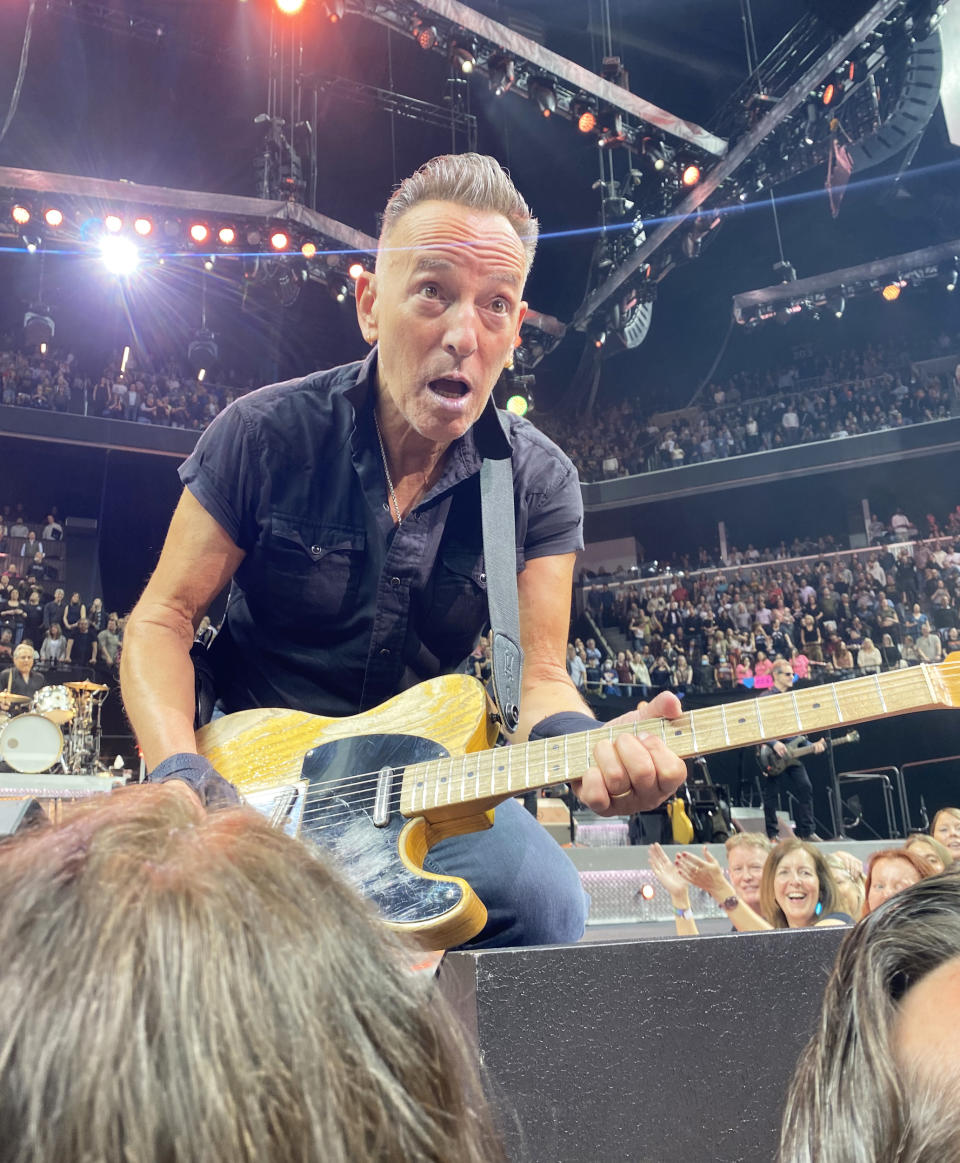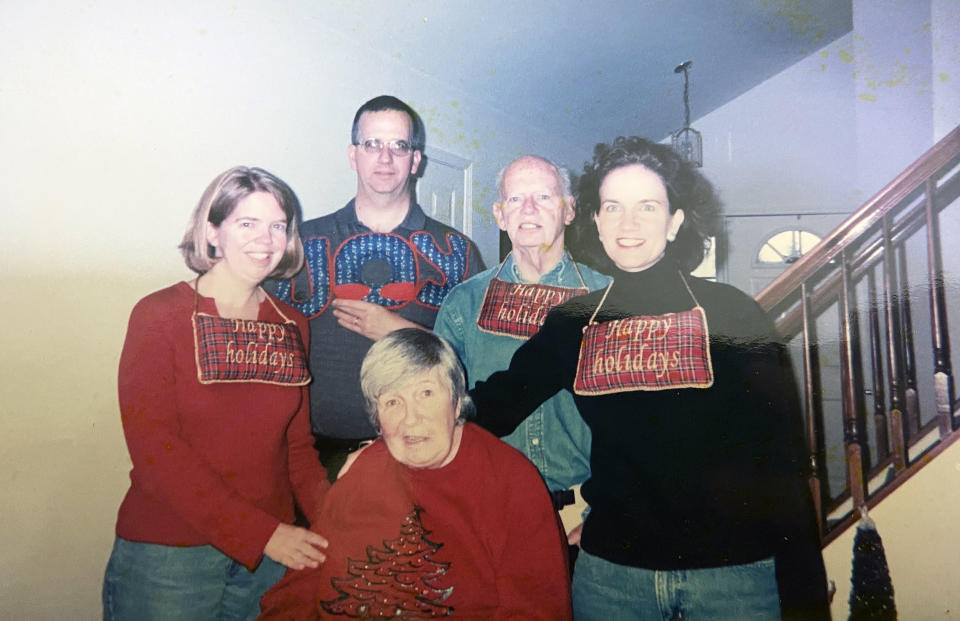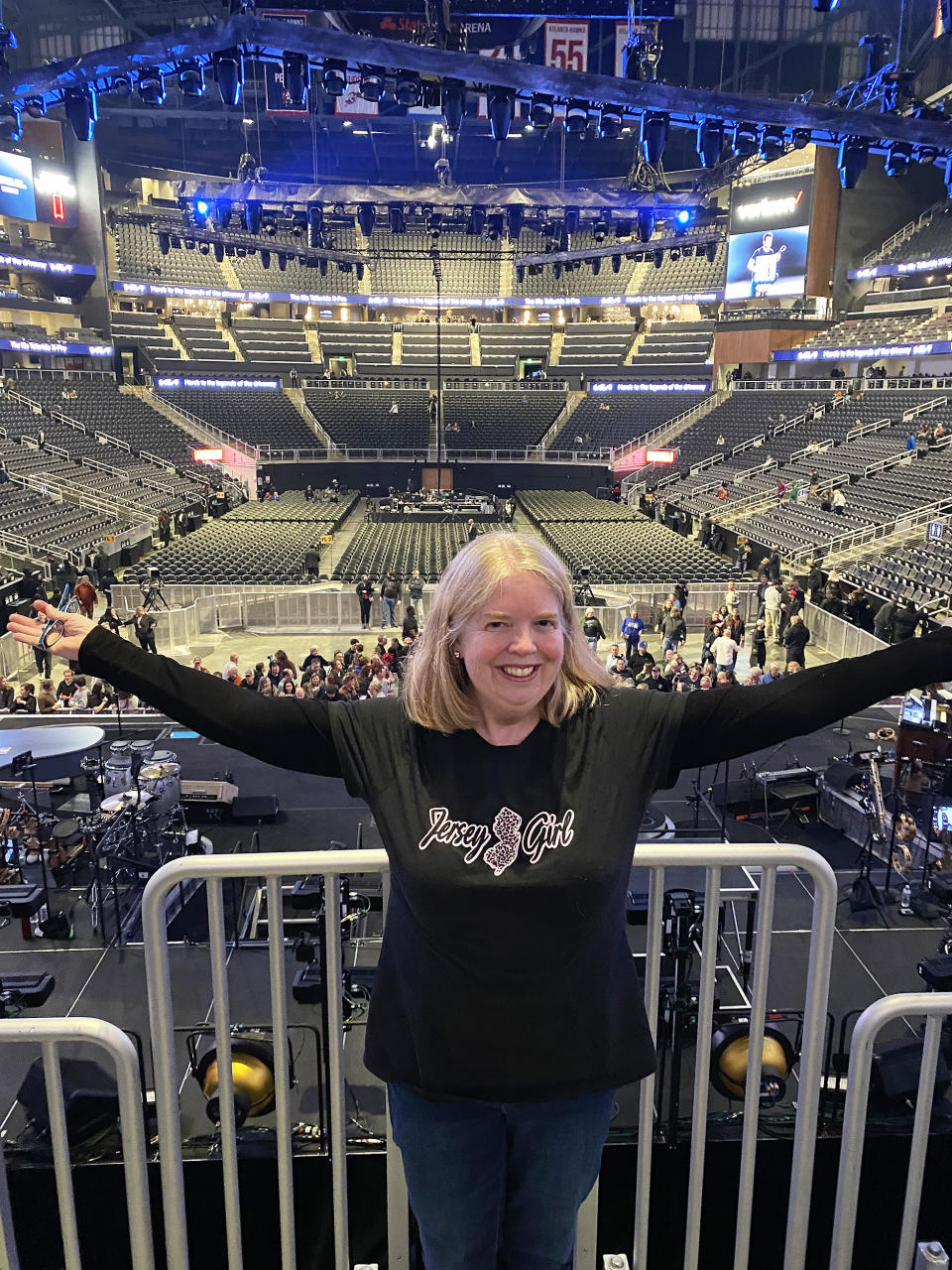After my mom died, going to Bruce Springsteen concerts became my therapy
- Oops!Something went wrong.Please try again later.
I’m standing second row in the pit at Brooklyn’s Barclays Center, with Bruce Springsteen so unbelievably close I have to remind myself he is not a figure in a wax museum. That’s sweat on real flesh soaking the rock star’s shirt — Madame Tussauds couldn’t replicate that. As Springsteen strums, sings and grooves, I sigh because I know I’m where I’m supposed to be.
It’s my fourth show of the tour, and I expect to hit 17 before this year ends, from Sweden to San Francisco, Atlanta to Montreal. I was never one of those Springsteen fans who went to many shows of a tour, hopping planes and tallying my concert count. But at my first show of this tour, five months after my mom died, I discovered a rock concert with 18,000 strangers was more therapeutic for my grief than a counselor’s couch. And not any ol’ concert, but seeing Springsteen and the E Street Band, the top thing I pined to do during the pandemic.

Some fans have criticized Springsteen for playing a static set list, instead of improvising, grabbing signs from the crowd and ripping into obscure songs. But Springsteen has signaled he has a story to tell this tour. With a set list heavy on loss and legacy, but also optimism and endurance, Springsteen concerts have been teaching me about death, and how to heal. At each show, I discover a new nugget or something I missed last time. This isn’t about queuing up a playlist on Spotify, but being there with others, who offer their own lessons, if I’m open to them. One person in a crowd of 18,000 can be that night’s reminder that all of us are remembering someone, whether it is the father waving a sign commemorating his son lost to suicide, or Jake Clemons raising his head heavenward after his “Jungleland” sax solo as a tribute to his uncle.
I bought my first ticket for this tour six weeks before my mom died. As my mother pinballed in and out of the hospital, and then went on hospice, I’d sit by her bedside, imagining the concert, the Bruce ticket a balm to the anxiety I felt as my mom slipped away.
Family has been tied to my Springsteen experiences, and not just because I grew up at the Jersey Shore. My first concert was in August 1985 at Giants Stadium in New Jersey. I was 17, and my 20-year-old brother drove, and then deigned to sit with me at the show. The band played “Jersey Girl,” and I slept that night in my sleeveless Born in the USA tour shirt.
Eighteen years later, I was at Giants Stadium with my sister on another August night. My mom had said she hoped Springsteen would sing “Jersey Girl” for her two daughters, and he did, one of only two times the band performed the song during 120 shows of “The Rising” tour, according to setlist.fm. As the first notes started, we called our mom and held the phone toward the stage. During the din, we couldn’t talk to her; all we saw was that the other end of the line had been picked up. Later we learned our mother had been dancing around our kitchen, the phone to her ear, the extra-long cord to the wall phone giving her leeway for some moves on the linoleum. Less than a month later, my mom had a massive stroke, paralyzing her left side and confining her to a wheelchair. She never danced again.

When my mom was in the ICU immediately after her stroke in 2003, her life expectancy was measured in hours, then days. Her carotid artery on one side was completely blocked, the other side marginally better. She was not a candidate for surgery. Once my mother stabilized, her doctors gave a low percentage that she might live five more years. Instead, my mom survived for 19 years. Until she didn’t. Last summer, after 16 nights in the hospital over five weeks, and modern medicine’s failed attempts to cure her heart, it became clear hospice was the best, only, course.
My mother died a week later, at home, her family by her side. The hustle of funeral planning started immediately. The parade of people at the wake, the soprano’s voice echoing in the church, the uneven soil at the cemetery as we held each other up to navigate the ground, our grief. At the repast, my cousin said, “Just wait until your mom comes to you in your dreams.” I waited and waited, but she never came.
Five months later, I flew to Atlanta to my first Springsteen concert of this tour. “Death’s great gift is expanding vision,” Springsteen said as he introduced “Last Man Standing,” a song about a member of his first band dying. “At 15, it’s all about tomorrows, it’s all hellos. At 73? It’s more goodbyes. It makes you realize how important living right now is.”

I choked up when he said it. The anticipation of the concert had sustained me through my toughest goodbye yet. Now, here was Springsteen teaching me about death, thanks to a carefully curated set list. Springsteen shows became a vehicle for processing my grief, as I funneled cash into more concert tickets instead of therapy. I had tried an online grief support group, mourners sharing their pain inside Zoom gallery boxes. Springsteen, a celebrity, was more untouchable than anyone on that Zoom, yet he was doing a better job showing me how to heal, and honor the dead.
My mom’s passing made me face my mortality as no other death had. As I waited for my mom to come to me in my dreams, I kept buying concert tickets, learning lessons about loss and hearing reminders to remember — and to live.
I knew I had to be at the Newark, New Jersey, show in April. The band might play “Jersey Girl.” When the encore started, Springsteen picked his way through the opening notes of the song he’s played publicly only a handful of times since I heard it live in 2003, and suddenly it was just me in that arena as “Jersey Girl” filled the space. I flashed back to my mother dancing on the linoleum of our kitchen, an image so indelible even though I never saw it. Then I was at my mom’s bed as she drew her last breath. Then came an amorphous image of her in heaven, looking down at the concert venue, as I wondered if there were kitchens and linoleum in such a place. I braced myself for sobs to unleash, but instead I felt breathless, searching for air through the emotion of it all.
I was awake, but it felt like I was seeing her in my dreams.
My mom died Sept. 4, 2022. Springsteen plays New Jersey’s MetLife on Sept. 3, 2023. This Jersey Girl will be there for a coda on a year of mourning.
This article was originally published on TODAY.com

